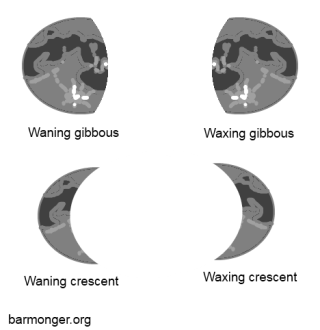In my
previous post I talked about the Moons orbit around the Earth and some of the science behind it.
I also mentioned that this Saturday (yesterday) was a full moon, but unfortunately the sky here was cloudy so I couldn't get any good pictures.
Instead I'll continue my talk about the Moon; this time it's going to be about the phases of the Moon.
As usual, you can click the images/diagrams for larger versions.
Edit: I've removed the trivia section to shorten the post a bit. I'll repost it in a trivia post at the end of the series.
The phases of the Moon
You've probably noticed that the Moon goes through four distinct phases every month:
New (the Moon is almost invisible), crescent (less than half), gibbous (more than half) and full.
Apart from the four main phases the two middle phases (crescent and gibbous) also have two different sub-phases: waxing (growing) and waning (dwindling). You'll notice that the Moon appears to "fill-up" and later "disappear" from the right. This is due to the way the Moon orbits the Earth, which you can see in the orbit diagrams in the
previous post.
In between the waxing and waning phases there are two half-full states as well.
Now, you can argue that the main phases are full, new, waxing and waning instead of full, new, gibbous and crescent.
And sure the Moon is going through a "growing" phase and a declining phase, but I feel that the crescent Moon is such an iconic image that it deserves to be a phase.
And although I said every month, what I really mean is that the Moon goes through these phases every
Lunar month (the 29.5 day cycle) not every calendar month.
Why does the Moon have phases?
As you've probably figured out by now, the phases of the Moon are caused by the Moons orbit around the Earth and the position it has in respect to us. The Sun lights up the side of the Moon that is facing the Sun, similar to how it lights up the part of the Earth that is facing it (the day side). The other side is completely dark. The phases are
not caused by the Earth's shadow being cast on the Moon, although the Moon can move into the Earth shadow, which it does a
few times every year. This is called a Lunar eclipse and can only occur when the Moon is full. It produces magnificent views like this:
Full Moon is when the Moon is opposite the Sun in respect to the Earth. That is the side of the Moon that is facing the Sun is also facing the Earth and we get to see a completely lit up Moon.
New Moon is the opposite. In this phase the Moon is between the Earth and the Sun and the side of the Moon that is being lit is facing away from the Earth. The Moon is almost invisible during the day and only slightly visible during the night (mainly because of Earth-shine, where sunlight reflected off the Earth lights up the Moon).
During the
waning period the Moon is "in front" of the Earth in its orbit around the Sun and we'll see the Moon decline from the right as the side that is lit up by the Sun slowly creeps out of our view.
And finally during the
waxing period the Moon is "behind" the Earth catching up in its orbit and slowly growing in visible size as the lit side rotates to face us.
Now you know everything about the phases of the Moon :-).
Next time (in part 3) I'll talk about why it's always the same side of the Moon that is facing us.




0 comments:
Post a Comment